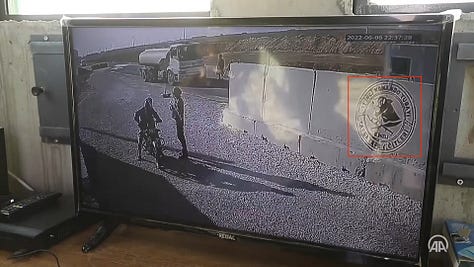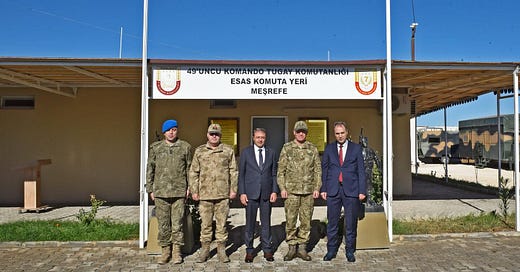Turkey's military footprint in the 'Peace Spring' region
A comparison to Turkey's presence in Iraqi Kurdistan, as detailed by the BBC
Last month BBC Eye published an extensive investigation detailing the extensive expansion of Turkish military bases inside Iraqi Kurdistan since 2018 as part of Turkey’s ongoing war with the PKK. They found that by December 2024 Turkey built at least 136 bases (or outposts) and 660km of new roads connecting them, mostly located in a 20km deep stretch along the border known locally as the ‘Forbidden Zone.’

Turkey began engaging the PKK inside Iraqi territory in the 1990s and has maintained at least one base (Bamarni Air Base) in the Kurdistan region since then. This presence has been abetted by the development of the Turkish-KDP partnership over the course of the last two decades, relating to both actors’ antagonisms to the PKK. The growth of Turkish bases - now representing an occupation of large portions of the Iraqi Kurdish side of the border rather than scattered islands of deployment - occurred following the breakdown of the PKK peace process in 2015, with the BBC finding that 89% of the December 2024 bases were built since 2018.
It’s worth mentioning to more casual observers that these Turkish-occupied areas are not the oft-mentioned Qandil mountains in which the PKK is based out of, which are located further south along the border with Iran inside the PUK-administered region. Since the 1980s the PKK has separately maintained a presence in these remote areas near the Turkish border on paper controlled by the KDP in order to infiltrate Turkey. With Turkey largely defeating PKK insurgency inside its border between 2015-2018, the war has moved south to this key access point.
The investigation - a mix of on the ground reporting and open source analysis - covers a range of other topics including the civilians killed in Turkish attacks and the struggle for their families to receive compensation, farmers blocked from accessing lands near bases, the Turkish-KDP relationship, and the dysfunctional state of the Kurdistan Regional Government. It also represents the opportunity to briefly discuss Turkish military bases in Syria, framed by the government as an extension of the same war against the PKK.
Last year I contributed to a report published by Syrians for Truth & Justice covering HLP violations in the ‘Peace Spring’ area of eastern Syria - the area captured by Turkey in its 2019 operation of the same name. The annex of the report, beginning on page 32, highlights 68 Turkish military installations of varying sizes in the region. This figure is almost equal to the combined number of Turkish positions active in late 2024 in the regions of Idlib, Afrin, and Euphrates Shield to the west.
The geography of the Turkish presence in Syria and Iraqi Kurdistan differ in clear ways due to the distinctive conflict dynamics. Whereas in the latter Turkey’s motivation is completely tied to the PKK conflict, its intervention in Syria was also prompted by a desire to end refugee inflow via carving out and protecting areas outside regime control. This has subsequently meant significant Turkish involvement in local governance and the economy. Turkish HLP violations have certainly occurred in Syria, as the report details, but at a certain level locals represent more of a Turkish constituency than is the case in Iraqi Kurdistan where Turkey has no relationship with and has assumed no responsibility for local civilians. Meanwhile civilian casualties caused by Turkish attacks in Syria occur in SDF-controlled areas, the relationship between Turkey and that population distinctive from both that of Turkish-controlled areas of Syria, and the KDP-administered areas of Iraqi Kurdistan.
In the Afrin, ‘Euphrates Shield,’ and ‘Peace Spring’ areas, the military bases and positions active in 2024 were built or significantly expanded after areas were cleared in operations (during which more temporary bases were erected and later abandoned). The vast majority of these installations existed on what was the front lines between Turkey and the SNA on one side, and the SDF and/or the regime on the other, and served primarily to solidify the lines frozen via Turkish and Russian agreement. Deeper inside these areas larger bases were built to serve as command and logistics centers, but local interior security of the Afrin, ‘Euphrates Shield,’ and ‘Peace Spring’ regions was handled by Turkish Ministry of Interior forces (Jandarma and Police Special Forces) and Syrian partner forces rather than the Turkish military.
In Iraqi Kurdistan Turkey has been conducting a phased counter insurgency over several years in remote unpopulated or depopulated areas in very different terrain. The terrain of these border areas represent what people imagine when they think of Kurdistan: tall mountains covered in small trees and shrubs, deep valleys with regular 1,000m drops in elevation.
Like almost all of eastern Syria the ‘Peace Spring’ region is a wheat and barley producing steppe with little to no topographical features apart from scattered neolithic tells and meandering rivers. In Iraqi Kurdistan Turkey is fighting guerilla force living in an extensive tunnel network for control of the border area, whereas the Turkish military has been static in Syria since 2019 with Turkish intelligence’s drone assassination campaign being the primary anti-SDF activity .
The findings in the report’s annex show that majority of the military installations in the ‘Peace Spring’ area are located within 10km of the front lines, often small defensive positions featuring several hull down tank positions and pre-fabricated structures linked to one another via a contiguous defensive berm. Bases located further back are often larger and some feature obstacle courses, shooting ranges, and helipads. Additionally Turkey has also repaired and fortified an airstrip previously operated by the Syrian government’s Department of Agriculture near the town of al-Mabroukah. Also detailed in the annex are several sites belonging to Turkish Ministry of the Interior forces, all found in or around the region’s major towns of Serê Kaniyê/Ras al-‘Ain, Tell Abyad, and Suluk.
Some information has been published by both the government and in Turkish media regarding what units are deployed to eastern Syria. The 49th Commando Brigade from Bingöl province maintains its Main Command Station at the now mostly destroyed village of Mishrifah, a major checkpoint south of Ras al-‘Ain, while also manning the front line al-Dawoudiyah base (video below) to the east.

The 11th Commando Brigade from Denizli is stationed at a large base (see video below) near the village of Ma‘roudah, under 4km from the ‘Ain ‘Isa front lines, while also controls a checkpoint on the al-Raqqah-Tell Abyad road near the village of Umm Guwayr which includes a memorial (marked on Google Maps) to members of the unit killed during Operation Peace Spring.



These 68 locations are all viewable here on this interactive map. Some may have since been abandoned as the information was mostly collected via Google Earth imagery c. 2022/23. Additionally it’s possible that there has been significant Turkish troop movement since the fall of the regime in December 2024, though the ensuing events did not change the shape of the ‘Peace Spring’ front line and there’s no indication that Turkey’s presence in the region has changed in any capacity. Furthermore, judging by lack of mention in Syrian government press, these areas appear to be outside its control instead administered by Turkish-backed local councils with Turkey and the SNA maintaining their military and security force deployments.
In comparison to Turkey’s extensive military presence in northeastern Syria check out my piece last month on the handful of US bases in the region, three of which the US is reportedly now in the process of dismantling…
The US military footprint in northeastern Syria
This is a brief open source guide to the US military’s presense in SDF-controlled northeastern Syria. Below I highlight the nine bases in operation since the late 2019 partial withdrawal from Syria that saw the military vacate several bases in the Aleppo and al-Raqqah governorates, built in previous years as part of the anti-Islamic State campaign. Seve…





